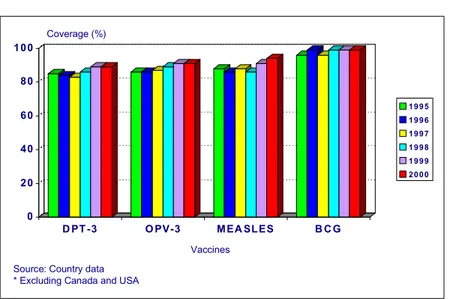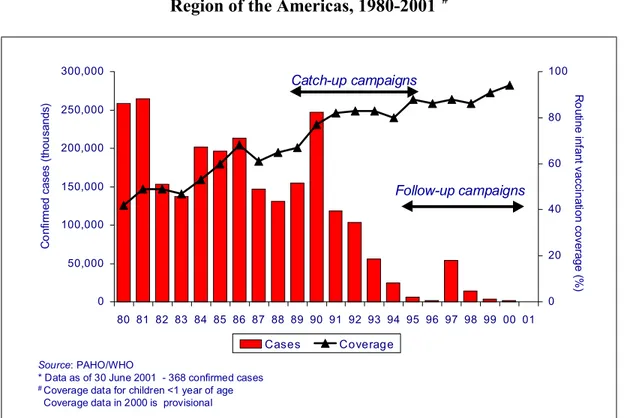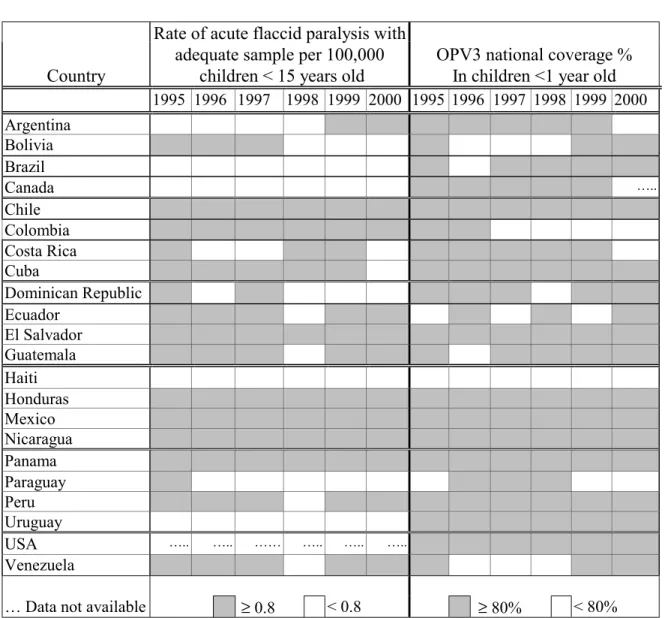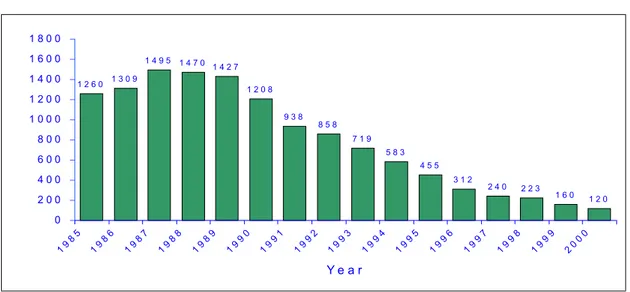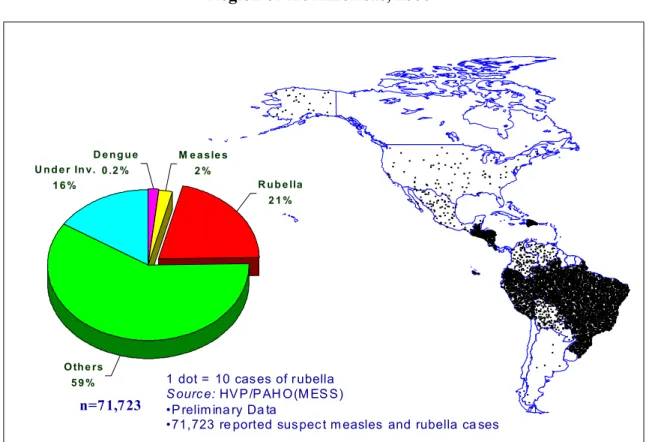43
rdDIRECTING COUNCIL
53rd SESSION OF THE REGIONAL COMMITTEEWashington, D.C.,USA, 24-28 September 2001
Provisional Agenda Item 4.3 CD43/7 (Eng.) 11 July 2001
ORIGINAL: ENGLISH
VACCINES AND IMMUNIZATION
The following report updates the Directing Council on Member States’ efforts in controlling and eradicating vaccine-preventable diseases.
As noted, the goal of measles eradication in the Americas is within reach. Currently, only the Dominican Republic and Haiti have evidence of endemic measles transmission. Regarding poliomyelitis, the recent development of a vaccine-derived poliovirus outbreak on Hispaniola and its potential implications for the Region, as well as for the global polio eradication initiative, are reviewed. The latest developments regarding yellow fever in endemic countries remain a concern, especially the imminent danger of its re-urbanization. In neonatal tetanus, the report stresses the next steps in the control of the disease, which is now confined to less than 1% of all districts.
In the area of vaccine introduction, the report emphasizes the importance of the existence of regional, as well as country-specific, information on disease burden, to clearly show the potential impact of vaccination in terms of lives and costs saved when compared to other interventions. A review is also presented of PAHO’s work with Member States to ensure safe immunization and the Organization’s efforts to emphasize an approach that includes the use of quality vaccines, safe injection practices, and the expeditious management of any event attributed to vaccination. The report makes a cautionary note about the current vaccine shortage affecting countries worldwide, which could jeopardize the implementation of current and future immunization activities in the Americas.
During its discussion the 128th Executive Committee reiterated its support for reaching the goal of measles eradication in the Americas, and of maintaining the goal of polio eradication. The Committee pointed out that it is important for other Regions to move into accelerated control of measles, which remains one of the world’s deadliest childhood diseases and for which an inexpensive vaccine is available. The Committee also noted that achieving measles eradication and maintaining the Americas polio-free will require the kind of sustained political will as has been shown by Member States so far, as well as ongoing commitment by health authorities and health workers and the international community. The Executive Committee emphasized the need for Member States to pay attention to areas of low vaccination coverage within their countries, and to assure a reserve stock of vaccines due to the global shortage in supply.
CONTENTS
Page
1. Vaccination Coverage ... 3
2. Progress Towards Measles Eradication... 4
3. Maintenance of Poliomyelitis Eradication ... 6
4. Neonatal Tetanus... 8
5. Yellow Fever ... 9
6. Rubella ... 10
7. Vaccine Introduction ... 11
8. Safe and Quality Immunization... 12
9. Vaccine Supply... 14
10. Action by the Directing Council ... 15
1. Vaccination Coverage
In 2000, vaccination coverage of children under 1 year of age in the Region of the Americas showed levels above 90% for most antigens (Figure 1).
Figure 1. Vaccination coverage of children <1 year of age. Region of the Americas*, 1995-2000
0 2 0 4 0 6 0 8 0 1 0 0
D PT -3 O PV-3 M EA SL ES B C G
1 9 9 5 1 9 9 6 1 9 9 7 1 9 9 8 1 9 9 9 2 0 0 0
Source: Country data * Excluding Canada and USA
Coverage (%)
Vaccines
Overall regional DPT vaccine coverage in 2000 was 89%; 19 out of 36 reporting countries (53%) had coverage of > 90%. Five countries reported DPT3 coverage less than 80%: Colombia (74%), Dominican Republic (78%), Haiti (59%), St. Lucia (70%), and Venezuela (77%).
Overall regional vaccine coverage with three doses of oral polio vaccine (OPV) in 2000 was 91%; 19 out of 36 reporting countries (53%) had coverage of > 90%. Seven countries reported OPV3 coverage less than 80%: Colombia (78%), Costa Rica (79%), Dominican Republic (67%), Guyana (78%), Haiti (58%), Paraguay (73%), and St. Lucia (70%).
Overall regional BCG vaccine coverage in 2000 was 99%; 28 out of 31 reporting countries (88%) had coverage of > 90%. Two countries reported coverage less than 80%: Haiti (57%) and Paraguay (79%).
These figures show that Member States duly recognize immunization as a priority health intervention within the national health agenda. PAHO is emphasizing the reduction of existing disparities in access to vaccination within countries. Vaccination coverage at municipal levels is being regularly monitored and the development of national strategies that effectively reach unvaccinated population groups are being promoted. These groups include seasonal workers, persons living in remote rural areas without adequate means of communication, rural-to-urban migrants, urban dwellers in underserved areas, and indigenous populations. In this regard, it is critical that Member States secure a steady flow of resources towards identified risk areas, follow-up of progress being made, and develop innovative outreach strategies that are sensitive to local cultural practices.
PAHO continues to emphasize the use of partnerships and alliances to strengthen immunization services of Member States. These now include: An initiative with the education sector to increase the demand for immunization services among pre-school and elementary schoolchildren; the private sector to encourage monitoring of suspected cases of vaccine-preventable diseases by the private medical sector; the World Bank under the umbrella of the Shared Agenda, and the Global Alliance for Vaccines and Immunization.
Efforts also continued in evaluating the impact of health reform and decentralization on the optimum delivery of immunization and surveillance programs. Areas of concern remain the timeliness and reliability of vaccination coverage data from the local levels, the efficient use of local financial resources and adequate planning of immunization campaigns, as well as the absence of mechanisms to accredit and supervise new private facilities that deliver vaccination services.
2. Progress Towards Measles Eradication
Figure 2. Vaccination coverage and reported number of measles cases. Region of the Americas, 1980-2001*#
0 50,000 100,000 150,000 200,000 250,000 300,000
80 81 82 83 84 85 86 87 88 89 90 91 92 93 94 95 96 97 98 99 00 01 0 20 40 60 80 100 Cases Coverage
Source: PAHO/WHO
* Data as of 30 June 2001 - 368 confirmed cases
# Coverage data for children <1 year of age
Coverage data in 2000 is provisional
Catch-up campaigns Follow-up campaigns R o ut ine inf ant v a c c in a tion c o v e ra g e ( % ) C o nf ir m ed c as es ( thou s ands )
PAHO’s strategies to achieve, maintain, and monitor the interruption of endemic measles transmission in the Region include: (1) obtaining >95% routine coverage with
measles-containing vaccine in all municipalities. (2) carrying out follow-up measles
vaccination campaigns at least every 4 years with at least 95% vaccination coverage in all municipalities; (3) vaccinating and monitoring coverage among groups at high-risk for acquiring or transmitting the disease; (4) conducting reliable, routine surveillance for vaccine-preventable diseases; and (5) investigating all outbreaks.
Haiti and the Dominican Republic deserve special attention. Despite repeated vaccination efforts, both countries have been unable to stop measles transmission. Problems have included the failure to fully implement the measles eradication strategy, insufficient supervision of vaccination campaigns, inadequate and delayed monitoring of vaccination coverage, and severe logistical obstacles.
Member States are commended for their commitment to reaching the goal of measles eradication. Achieving and maintaining zero measles in all countries of the Americas will require the kind of sustained political will as has been shown by Member States so far, as well as the ongoing commitment of health authorities, health workers and the international community. At this stage of the eradication initiative, the main objective is to reduce the population susceptible to measles virus by using the complete measles eradication strategy recommended by PAHO.
3. Maintenance of Poliomyelitis Eradication
The Region of the Americas is about to complete its 10th year without indigenous
transmission of wild poliovirus. The last case of paralytic poliomyelitis caused by wild poliovirus in the Americas occurred in Peru in August 1991. Current efforts are focused on maintaining the Western Hemisphere free of the spread of virus that could be imported from other regions of the world that still have wild poliovirus transmission.
Table 1 shows the results of a recent assessment made by PAHO of country risk of failing to detect poliovirus circulation, based on the performance of national surveillance systems in the last five years and the level of vaccination coverage reached during those same years in Canada, Latin American countries, and the United States. A similar analysis is being performed for countries in the Caribbean. This information allows Members States to clearly determine areas that will require immediate action.
Table 1. Countries of Latin America, Canada and the United States 1995-2000
Country
Rate of acute flaccid paralysis with adequate sample per 100,000
children < 15 years old
OPV3 national coverage % In children <1 year old
1995 1996 1997 1998 1999 2000 1995 1996 1997 1998 1999 2000 Argentina
Bolivia Brazil
Canada …..
Chile Colombia Costa Rica Cuba
Dominican Republic Ecuador
El Salvador Guatemala Haiti Honduras Mexico Nicaragua Panama Paraguay Peru Uruguay
USA ….. ….. …… ….. ….. …..
Venezuela
… Data not available ≥ 0.8 < 0.8 ≥ 80% < 80%
Dominican Republic, three national immunization rounds with OPV targeting children <5 years have already been implemented, in December 2000, as well as in February and May of 2001. In Haiti the strategy of rolling campaigns for polio and other antigens is being used to control this outbreak.
Prolonged circulation of vaccine-derived poliovirus in areas with very low OPV coverage has only been documented in one other setting—a type 2 OPV-derived virus that circulated in Egypt for an estimated 10 years (1983-1993) and was associated with more than 30 reported cases. Vaccination coverage was quite low and circulation of the vaccine-derived poliovirus was terminated rapidly once OPV vaccination coverage increased.
Among the actions being taken are the determination of the real extent of the outbreak, especially in Haiti where just three cases have been identified, as well as the risk factors and potential for future outbreaks. Currently, all Sabin poliovirus isolates from AFP cases in the Americas since 1995 are being sequenced in conjunction with epidemiological analysis of those high-risk areas where new Sabin-derived poliovirus has been identified. Given this new development, additional studies will be required before deciding whether to discontinue polio vaccination once global eradication has been achieved.
PAHO makes a special call to all Member States to remain highly vigilant of this situation by maintaining high levels of OPV coverage and active surveillance in all areas of countries.
4. Neonatal Tetanus
The incidence of neonatal tetanus (NNT) continues its downward trend in the Region of the Americas. In 1987, there were 1,495 cases reported; in 1999 there were 160 reported cases; and in 2000, there were 120 cases reported (Figure 3). The disease is now confined to less than 1% of all districts in the Americas. Epidemiological characteristics of cases show that they are rural infants of multiparous women lacking prenatal care, who are unvaccinated, and deliver predominantly at home.
using every contact of women of child-bearing age with a health center as an opportunity for vaccination against the disease.
Figure 3. Reported cases of neonatal tetanus in Latin America, 1985-2000*
1 2 6 0 1 3 0 9
1 4 9 5 1 4 7 0 1 4 2 7
1 2 0 8
9 3 8 8 5 8
7 1 9 5 8 3
4 5 5 3 1 2
2 4 0 2 2 3
1 6 0 1 2 0
0 2 0 0 4 0 0 6 0 0 8 0 0 1 0 0 0 1 2 0 0 1 4 0 0 1 6 0 0 1 8 0 0
19 85 19 86 19 87 19 88 19 89 19 90 19 91 19 92 19 93 19 94 19 95 19 96 19 97 19 98 19 99 20 00
Y e a r
Source: PAHO, 2000.
* Argentina, Bolivia, Brazil, Colombia, Dominican Republic, Ecuador, El Salvador, Guatemala, Haiti, Honduras, Mexico, Nicaragua, Panama, Paraguay, Peru, and Venezuela
5. Yellow Fever
The imminent danger of re-urbanization of yellow fever in the Americas remains a
public health concern, because of the wide and ongoing dissemination of Aedes aegypti in
the 11 countries located inside the enzootic area (Bolivia, Brazil, Colombia, Ecuador, French Guiana, Guyana, Panama, Peru, Suriname, Trinidad and Tobago, and Venezuela). The growing movement of people, including those in the viremic phase, from enzootic areas, either by road or air, has greatly facilitated the introduction of the disease in urban areas, which currently have high rates of infestation with A.aegypti. In 1999-2000, there were 309 confirmed cases acquired in forested areas, with 149 deaths, the majority in Bolivia, Brazil, and Peru. In 2001, the most affected country has been Brazil, with 23 cases and 12 deaths, all acquired in the State of Minas Gerais.
recommended that a comprehensive vector control program be established by countries to lower the density of A. aegypti in urban environments.
6. Rubella
For 2000, data on rubella obtained through PAHO’s regional measles eradication surveillance system showed that out of 71,723 laboratory analyses performed on samples of suspected measles cases, 11,992 (21%) were confirmed as rubella (Figure 4). Bolivia, Brazil, the Dominican Republic, Ecuador, Guatemala, and Peru reported 92% of all confirmed rubella cases. Of these countries, Brazil, Honduras, and Peru have integrated their measles and rubella surveillance systems.
Figure 4. Laboratory confirmed rubella cases Region of the Americas, 2000*
1 dot = 10 cas es of r ubella S ourc e: HV P /P AH O (M ES S ) •P relim ina ry Da ta
•71,723 re ported sus pec t m easles and rubella ca ses
U n d e r In v . 1 6 %
O th e rs 5 9 %
R u b e lla 2 1 % M e a s le s
2 % D e n g u e
0 .2 %
n=7 1,7 23
Cuba, the United States, and Uruguay have used measles-mumps-rubella vaccine (MMR) for several years, and large cohorts of women of child-bearing age are being protected.
The English-speaking Caribbean countries are on their way towards achieving the CARICOM goal of rubella eradication and prevention of congenital rubella syndrome (CRS). Eighteen of the 19 countries have already carried out, or are in the process of completing, their rubella campaigns. The targeted population (men and women) in the 20-39 year age group is approximately 2.2 million. Costa Rica’s Ministry of Health and its Social Security Administration have developed an action plan for rubella. The Plan aimed to implement a national mass campaign for men and women 15-39 years of age with rubella- and measles-containing vaccine from early May to late May 2001, maintain MMR in childhood vaccination schedules, vaccinate against rubella all postpartum women who have not been previously vaccinated, update and strengthen the integrated measles and rubella surveillance system, and develop a CRS surveillance system.
Most of the available experience in CRS surveillance still comes from the English-speaking Caribbean. Given the importance of surveillance in preventing CRS and the still limited available data, two additional sources of information have been added—the Latin American Center for Perinatology and Human Development (CLAP) and the Latin American Collaborative Study of Congenital Malformations (ECLAMC).
PAHO is now focusing its technical cooperation on standardization of rubella/CRS surveillance system, the implementation of CRS reporting systems and networks, implementation of strategies to reduce the number of susceptible women of child-bearing age and follow-up of all pregnant women who have developed rubella, collection of samples for viral isolation from every outbreak, development of virus isolation capabilities in countries, and the promotion of appropriate vaccination strategies.
7. Vaccine Introduction
The rapid inclusion of a new vaccine against Haemophilus influenzae type b (Hib)
by most countries in the Region has provided important lessons for the incorporation of other new vaccines, either under development and/or that have been approved. The availability of new ways of delivering multiple antigens, such as combined vaccines, has facilitated even further the rapid incorporation of Hib and hepatitis B vaccine. A fundamental aspect of new vaccine introduction remains the existence of regional, as well as country-specific, information on disease burden, which clearly shows the potential impact of vaccination in terms of lives and costs saved when compared to other interventions.
ministries of health to monitor bacterial pneumonia and meningitis. This system was initiated in 1993 and included initially 6 countries in the Region (Argentina, Brazil, Chile, Colombia, Mexico, and Uruguay), but has gradually been expanded to include almost every single country. Data are being generated that provide information on prevalent pneumococcal serotypes responsible for invasive diseases in children and their antimicrobial susceptibility patterns; the impact of vaccination on Hib diseases; and in the near future, the status of meningococcal serogroups responsible for diseases in the Region.
More recently, surveillance has been improved in order to establish a bridge with ongoing clinical trials of pneumococcal vaccines using standard diagnostic criteria similar to those applicable in these trials. The information generated from the surveillance system will be analyzed and integrated with the results from the trials, thereby providing more precise information on the possible impact of the pneumococcal vaccine in each country. Parallel cost-effectiveness studies are being conducted that will generate comparative costs for different interventions. This critical information will be available in countries for decision-makers to act upon.
A similar approach is being followed for rotavirus vaccines and the same network of sentinel hospitals will be involved in monitoring rotavirus diseases, thereby strengthening hospitals' laboratory and diagnostic capabilities.
8. Safe and Quality Immunization
Monitoring immunization safety and integrating this aspect into the health system are complex responsibilities shared by national vaccination programs, national regulatory authorities, quality control laboratories, and health workers. PAHO is therefore emphasizing the use of an approach that includes the use of quality vaccines, safe injection practices, and the expeditious management of any event attributed to vaccination.
PAHO has been supporting efforts of the countries in the Region to use quality vaccines in their immunization programs through the PAHO Revolving Fund for Vaccine Procurement, strengthening national regulatory authorities (NRA) compliance with regulatory functions, the development of a regional system for quality testing of vaccines, and assurance that local vaccine producers comply with good manufacturing practices (GMP) and national/international requirements.
the year 2000, one professional from Brazil, another from Cuba, and two from Venezuela participated in this program.
Efforts have also focused on the harmonization of regulatory procedures in Central America and the Dominican Republic, which are aimed at the development of a unique subregional licensing process, the implementation of a regional database for vaccine lot release, and direct technical cooperation to respond to requests from countries. PAHO has also collaborated with the network of national control laboratories. A certification program has been initiated to establish regional laboratory capacity for specific vaccine testing, in support of the regional NRAs and PAHO’s Revolving Fund for Vaccine Procurement. The Laboratorio Nacional de Salud Pública in Mexico has already implemented the recommendations issued by an evaluation team. Chile and Venezuela have requested to be considered for a similar evaluation.
PAHO’s collaboration with Members States has also emphasized the maintenance of standards of vaccine quality and capability of incorporating new technologies for the production of new vaccines. Recognition by local vaccine manufacturers of the need to make the appropriate investments to upgrade their facilities, equipment, and procedures to comply with GMP and national/international requirements remains of key importance. PAHO is encouraging and supporting countries in conducting technical and economical feasibility studies to identify their strengths, weaknesses, and needs for improvement.
Bio-Manguinhos in Brazil and the Centro de Ingeniería Genética y Biotecnología in Cuba have both requested certification from WHO for yellow fever and hepatitis B vaccine. Colombia’s Instituto Nacional de Salud has undertaken a feasibility study and requested PAHO’s assistance in establishing priorities and alternatives for their production possibilities. An evaluation of the production department and the national control department of the Instituto de Salud Pública of Chile was conducted at the beginning of 2001, and results are being used by authorities in the reorganization of that institution.
Parallel to improving their facilities, local vaccine manufacturers must very rapidly develop a research and development infrastructure to update their portfolio of products. Some local producers have entered into joint ventures with major vaccine manufacturers for some particular vaccines. Examples are Bio-Manguinhos (Brazil) with Glaxo SmithKline for the production of Hib vaccine, the Instituto Butantán (Brazil) and Aventis Pasteur for influenza vaccine, and the Instituto Finlay (Cuba) with Glaxo SmithKline for meningococcal group B vaccine. There is still room to organize a research and development network involving local manufacturers, academia, and research groups to develop vaccines of regional interest.
concerns about the safety of vaccines. A rapid response to public health concerns regarding vaccines and the rapid communication of the rationale for actions taken will ensure the integrity of immunizations programs.
Brazil and Cuba have prepared their own manuals to educate health workers, and they have designed a system to monitor the frequency of adverse events. The Bahamas, Brazil, Chile, Guyana, and other countries in the English-speaking Caribbean are closely monitoring adverse events during vaccination campaigns. Brazil, Colombia, El Salvador, Guatemala, and Panama have also developed a rapid response to analyze and investigate events attributed to vaccines. In addition, Cuba is conducting a study on the link between the OPV vaccine and intussusception.
Stronger advocacy efforts will be needed to more widely disseminate the value of vaccines to individuals and the community at large, as well as their extraordinary contribution to reducing the incidence of childhood diseases. The experience so far has underscored the need to work more closely with the media to promote a better understanding by and communication within the community.
Further efforts are also required to address issues of injection safety. While policy initiatives regarding safe injection do exist in some countries, the lack of funding has made their implementation quite difficult. The cost of safely delivering vaccines and disposing of used injection equipment and other waste products should be included in regular immunization programming.
9. Vaccine Supply
An emerging issue that will challenge the effective implementation of immunization programs in the Americas is the severe shortage of global vaccine supply. The shortage of some vaccines that affected countries throughout 1999 and 2000 is likely to remain in the coming years, especially with OPV due to the accelerated effort to eradicate polio worldwide, and for combined vaccines—such as the pentavalent vaccine—which usually require a longer licensing time and only have one producer. Added demands have outstripped some manufacturers’ installed capacity to produce vaccines. Moreover, suppliers run the risk of experiencing quality control problems, which could further exacerbate the existing shortage of vaccines. This delicate situation will require that Member States assure a reserve stock of vaccines and that they plan their orders well in advance through the PAHO Revolving Fund for Vaccine Procurement.
10. Action by the Directing Council
The Directing Council is invited to consider the annexed resolution recommended by the Executive Committee.
128th SESSION OF THE EXECUTIVE COMMITTEE
Washington, D.C., 25-29 June 2001
RESOLUTION
CE128.R8
VACCINES AND IMMUNIZATION
THE 128th SESSION OF THE EXECUTIVE COMMITTEE,
Having considered the progress report of the Director on vaccines and immunization (Document CE128/10);
Taking into account the progress achieved by all Member States in the control of vaccine-preventable diseases and in the introduction of new vaccines, and the need for sustained commitment to successfully complete the goal of measles eradication and expand the use of vaccine technologies; and
Taking into account the comments made by the Executive Committee Members,
RESOLVES:
To recommend to the Directing Council the adoption of a resolution along the following lines:
THE 43rd DIRECTING COUNCIL,
Having considered the report of the Director on vaccines and immunization (Document CD43/_) and taking note of the progress being made by all countries in the control of vaccine-preventable diseases;
Acknowledging the commitment shown by all Member States to reaching the goal of stopping indigenous measles transmission in the Americas;
Considering the high activity in yellow fever transmission in the Region in the last two years in the enzootic areas, causing extensive outbreaks in several countries;
Cognizant that neonatal tetanus is now confined to less than 1% of all districts in the Americas and that the epidemiological characteristics of remaining cases indicate that there are infants of women lacking prenatal care who are unvaccinated and deliver predominantly at home; and
Recognizing the significant progress made by the Region of the Americas in sustainable vaccine introduction,
RESOLVES:
1. To urge Member States to:
(a) keep a high-level commitment to maintaining polio eradication and achieving
measles eradication by means of maintaining vaccination coverage at 95% or higher for polio and a measles-containing vaccine in each municipality and local community;
(b) allocate sufficient resources to sustain national inmunization programs and to
undertake the advance planning for the provision of vaccines and to ensure safe injections by putting in place mechanisms to prevent the re-use of syringes and needles or by the use of auto-destruct syringes;
(c) maintain high vaccination coverage with yellow fever vaccine in enzootic areas
and all areas infected by Aedes aegypti and at risk of urban transmission,
enforcing vaccination of travelers to enzootic areas, and implementing highly sensitive surveillance in enzootic areas;
(d) strengthen efforts to reduce the number of rubella-susceptible women of
childbearing age and prevent cases of congenital rubella syndrome (CRS) through the implementation of accelerated rubella vaccination strategies and enhanced surveillance for rubella and CRS;
(e) target special vaccination services and surveillance efforts in those areas and
population groups at highest risk within municipalities and uderserved pockets that still report isolated neonatal tetanus cases;
(f) support the development of an epidemiological infrastructure to generate
(g) strengthen national regulatory authorities and national control laboratories to ensure that only vaccines of quality, either imported or locally produced and approved by the competent authorities, are used in national immunization programs and the private sector.
2. To request the Director to:
(a) maintain a constant dialogue with vaccine suppliers to minimize the impact of the
global vaccine shortages on the Region of the Americas;
(b) stress the importance that national governments prioritize resources for vaccines
in their national budgets and promote the coordination of all partners that support national immunization programs to make maximum use of the flow of resources from the international level to complement national resources as appropriate;
(c) promote the periodic national review and evaluation of national immunization
programs to monitor progress and sustainability and adjust the strategies for the control and/or eradication of vaccine–preventable diseases;
(d) promote greater cooperation among researchers for the development of vaccines
and related products;
(e) work in close collaboration with all partners of the Global Alliance for Vaccines
